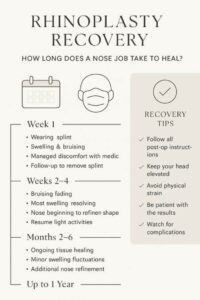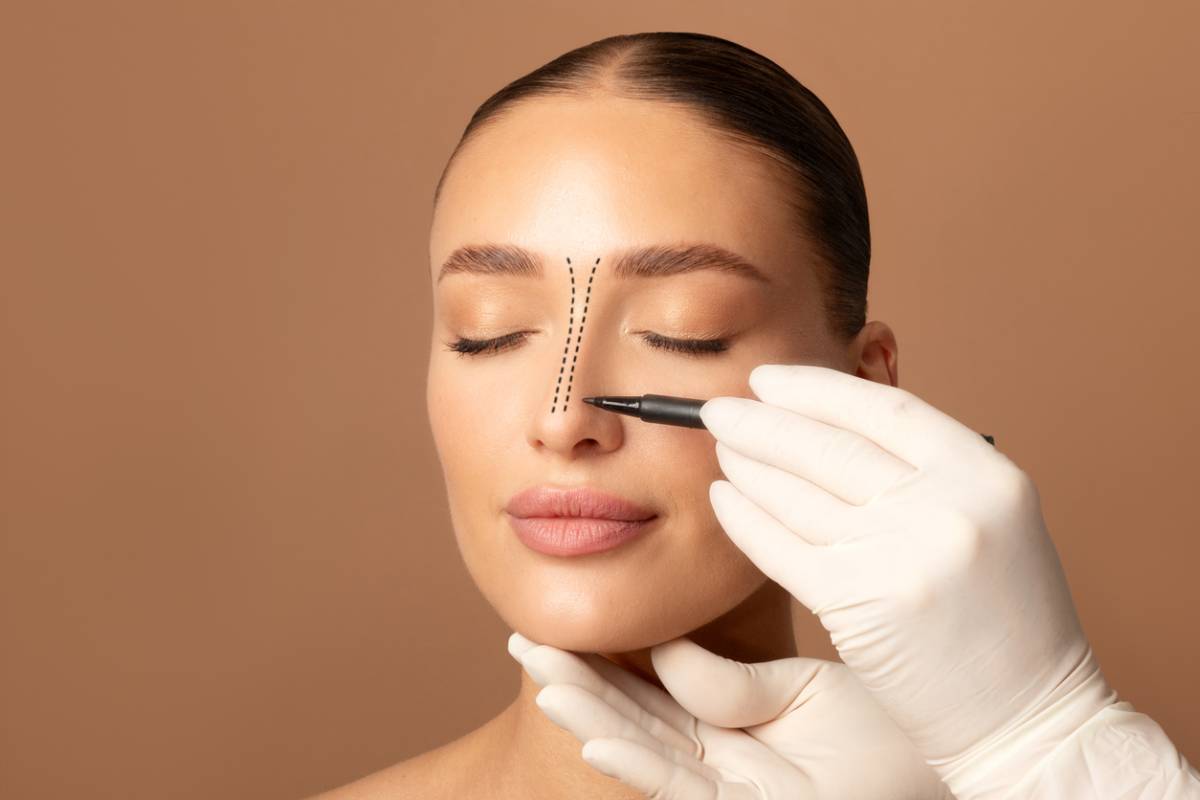Rhinoplasty, or as it’s more commonly known, a nose job, is a game-changer for your facial harmony. It does wonders to enhance the look of your nose and balance your features. And while the results can easily make you feel more confident and appreciate your features more, it’s still essential to understand what goes into the procedure, including what comes after, before you rush into it. For many patients, the recovery is just as important as, if not more important than, the procedure itself. That understanding leads many patients to the question, “How long does it take to heal after a rhinoplasty?”
Recovery times for rhinoplasty can vary depending on the complexity of your surgery, your body’s healing process, and the expertise of your plastic surgeon. But don’t worry! We’re here to guide you through what to expect during your recovery so you can feel confident and prepared every step of the way.
How Long Does a Nose Job Take to Heal?

Immediately after rhinoplasty surgery, your body begins the healing process. At this time, there will likely be swelling and bruising around the eyes and cheeks. This typically continues into the first week, during which patients will also generally wear a nasal splint. After a week to ten days, most patients feel well enough to return to work or school, even though some lingering swelling may persist.
Typically, the most noticeable healing occurs in those first few weeks. However, it’s essential to recognize that even after the bruising has subsided, healing after a nose job is a multifaceted process. While you’ll notice immediate reductions in bruising and swelling, true healing and settling can take up to a year or even longer.
What to Expect During Each Phase of Healing
Week 1
The first week at home after surgery focuses on rest and protecting your nose. This is when you’ll likely wear a splint, and you’ll probably feel at least some mild discomfort, although that’s usually well-managed with prescribed painkillers. Swelling and bruising will be at their worst at this point, but should begin to clear up towards the end of the week. At the end of this first week, you should visit your surgeon for a follow-up to remove the splint and assess your progress.
Weeks 2–4
By week two, most of the bruising should have faded, and the majority of the swelling should have resolved. Most patients feel more like themselves and can resume light social activities, including work or attending school.
Around weeks 3–4, many people notice a significant improvement in their profile and nasal contour. Though the nose may still feel slightly firm or tender, it begins to assume its refined shape. With their surgeon’s approval, many return to light exercise.
Months 2–6
While your nose is starting to look much better by this point, it’s essential to remember that deeper tissue healing continues. At this stage, your nasal structure is stabilizing, and the skin is adapting to the new underlying shape. You may still experience minor fluctuations in swelling due to weather changes, allergies, or physical activity, but these tend to be more temporary.
Up to One Year
A year might sound like a long time, but this is when the cartilage, bone, and soft tissues of the nose are fully settling. Around 6-12 months post-op, you’ll notice that the fine details of your new nose shape are emerging and that the swelling has completely subsided. Your nose will continue to feel more natural, and you’ll be able to enjoy your new lifelong look.
How to Support a Smooth Recovery Process
Follow Post-Operative Instructions Closely
One of the best ways to guarantee a smooth recovery is to follow all aftercare instructions. This includes avoiding physical strain, keeping your head elevated, maintaining a clean area, and attending all follow-up appointments.
Be Patient
Healing is a gradual process, and sometimes even a slow one, so it’s important that you do not judge your final results too soon. Try not to obsess over minor asymmetries or swelling in those first few months as the nose continues to refine. Remember, in the same way that every nose is different, every nose will take a different amount of time to heal after surgery.
Watch for Any Complications
While complications are rare with a skilled plastic surgeon, it’s important to watch for signs such as infection, excessive bleeding, or unusual swelling. Always reach out if you have any concerns, as early intervention often yields the best outcomes.
Your surgeon will provide specific instructions on what to look out for and when to call. Being proactive helps ensure a smooth recovery and long-lasting results.
Ready to Start Your Journey Toward a New Profile?
Book a consultation today with our expert team at Plastic Surgery Santa Barbara, and let us guide you through every step of your rhinoplasty journey.

